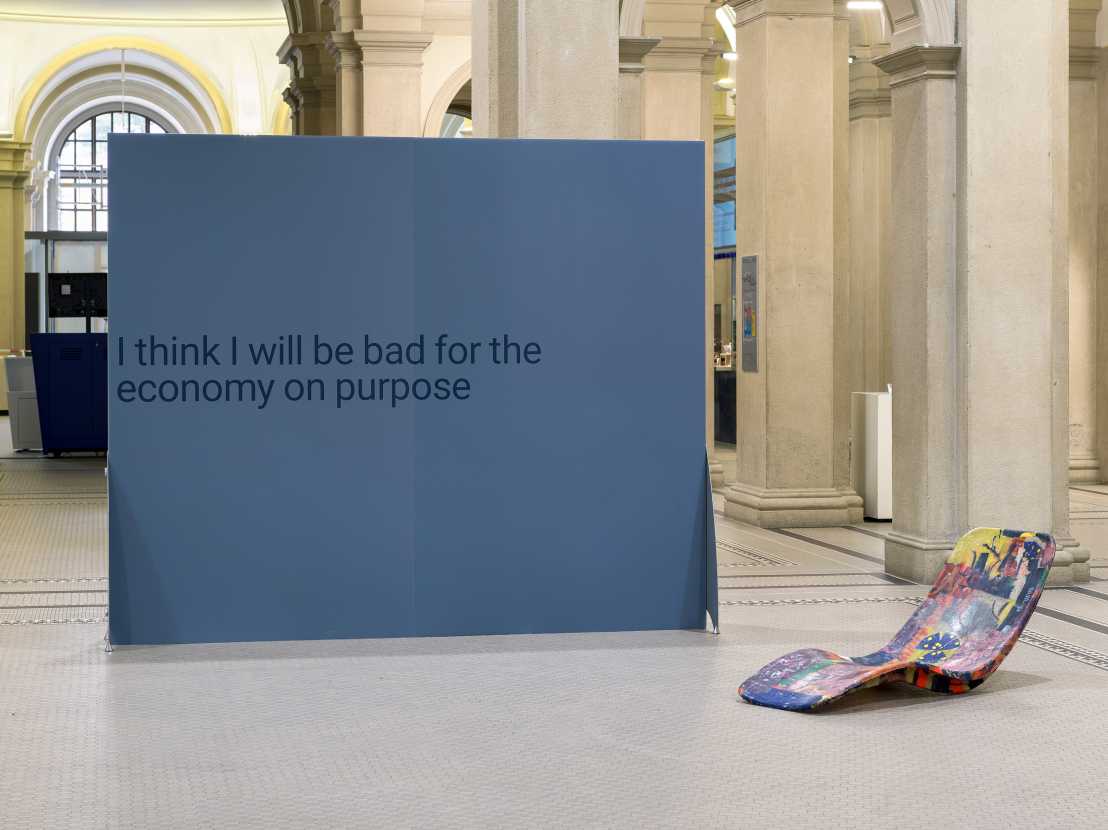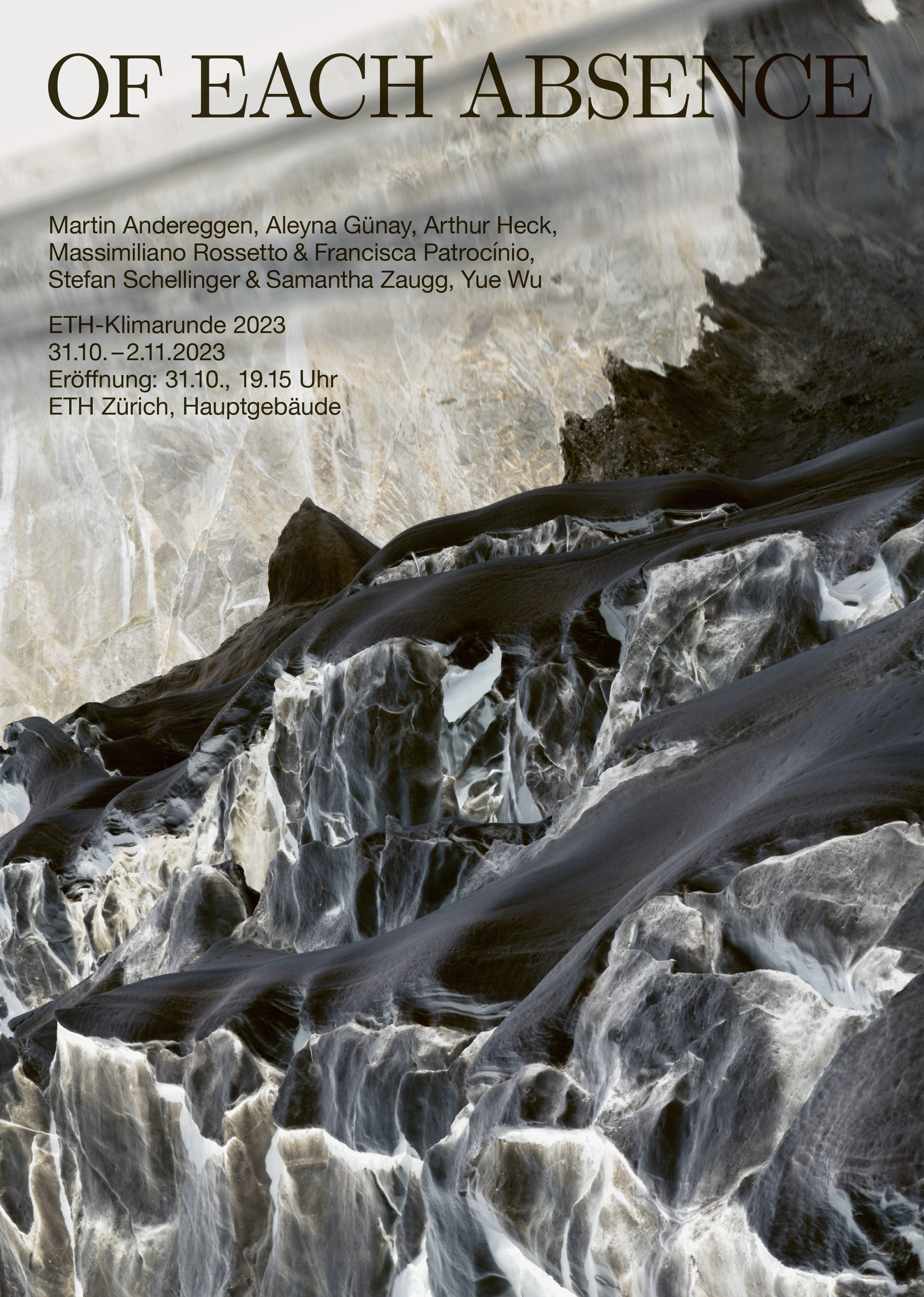ETH-Klimarunde: Kunstausstellung (DE)
Wie können wir auf das komplexe Wissen über die Klimakrise reagieren? Was bedeutet es, vom Denken zum Handeln überzugehen? Welche Perspektive können wir als Künstler einnehmen?
Teil 3 der ETH-Klimarunde
Eröffnung Kunstausstellung
Dienstag 31.10.2023, 19.15 Uhr
ETH Zurich Hauptgebäude, Haupthalle
Finissage: Art Walk
Donnerstag, 2.11.2023, 18.00-19.30 Uhr
ETH-Hauptgebäude, Haupthalle
Anlässlich des 10-jährigen Jubiläums der Klimarunde haben wir in Zusammenarbeit mit dem Master Fine Arts der Zürcher Hochschule der Künste (ZHdK) eine Kunstausstellung organisiert. Die Kunstwerke werden speziell für diesen Anlass von Studierenden des Masterstudiengangs geschaffen und parallel zur Klimarunde präsentiert.
Die Ausstellung ist vom 31. Oktober bis 2. November 2023 von 9 Uhr bis 20 Uhr für die Öffentlichkeit zugänglich.
Finissage: Art Walk
Wann: Donnerstag, 2. November 2023, von 18:00 bis 19:30 Uhr.
Wo: ETH Zürich, Hauptgebäude, Haupthalle
Erkunden Sie die Ausstellung aus der Perspektive der Künstlerinnen und Künstler. Begleiten Sie uns auf einem Rundgang durch die Ausstellung, der von den Künstlerinnen und Künstler selbst geführt wird. Erkunden Sie die Kunstwerke aus ihrer Perspektive, entdecken Sie die Geschichten hinter der Kunst und erfahren Sie mehr über den kreativen Prozess.
"Of Each Absence"
Nachrichten von Abwesenheit erreichen uns täglich: Gletscher ziehen sich zurück und hinterlassen Narben in der sommerlichen Landschaft. Seen und Flüsse führen zu wenig Wasser. Dürreperioden verringern Ernten. Im Winter ist es der ausbleibende Schnee, dessen Fehlen uns eine eine braune, schmutzige Landschaft hinterlässt. Als Gegenstück das Zuviel: Überschwemmungen, die Landstücke und Strassen mit sich reissen, lähmende Temperaturen.
Absenz und Präsenz sind aus dem natürlichen Gleichgewicht geraten. «The world dies of each absence» schreibt die belgische Philosophin Vinciane Despret. Sie erzählt vom (menschgemachten) Aussterben der Wandertauben als Teil einer Chronik der Ausrottung der Menschheit: jede Absenz ist Bruchstück eines langsamen Sterbens. Alles, was verschwindet, ist ein unwiederbringlicher Verlust für die Erde und die Menschheit. Dieses dramatische Verschwinden lässt sich auf die Klimakrise und den damit einhergehenden Verlust der Welt, wie wir sie kennen, übertragen.
Absenz verweist auf das Nicht-Handeln, Apathie und ein wachsendes Dilemma: wir versuchen zu verstehen, wir bemühen uns zu lernen, dennoch fehlt uns scheinbar die Fähigkeit zu handeln. Das Potenzial der Welt ist durch eine Anhäufung von Abwesenheiten begrenzt: Absenz kann als Leerstelle einer spekulativen Zukunft gelesen werden, als etwas, das fehlt, eine Welt, die noch nicht verwirklicht ist. Wir prägen das noch nicht Dagewesene, die zukünftige Gegenwart, mit den Handlungen unserer jetzigen Präsenz. Die Kunst und ihre Produktion sind voller Widersprüche und Komplexität, insbesondere wenn es darum geht, drängende Fragen der Gegenwart zu beleuchten. Mit anderen Worten: die Antworten von Künstler:innen auf die Klimakrise sind oftmals keine eindeutigen Botschaften, sondern sind eng mit dem Wissen und dem Diskurs über die Krisen der Gegenwart verflochten.
Die Arbeiten in der Ausstellung beziehen sich auf das Sichtbarmachen und spekulative Perspektiven in der Gegenwart komplexer Prozesse. Sie reflektieren komplexe Natur-Mensch-Relationen und sind aktivistisch, indem sie uns in Beziehung setzen, mit der Natur und mit unseren Mitmenschen, und indem sie über Wirtschaft und Politik nachdenken und unsere Sprache hinterfragen, durch unsere Fähigkeit, Wissen zu transformieren und anders zugänglich zu machen.
– Judith Welter
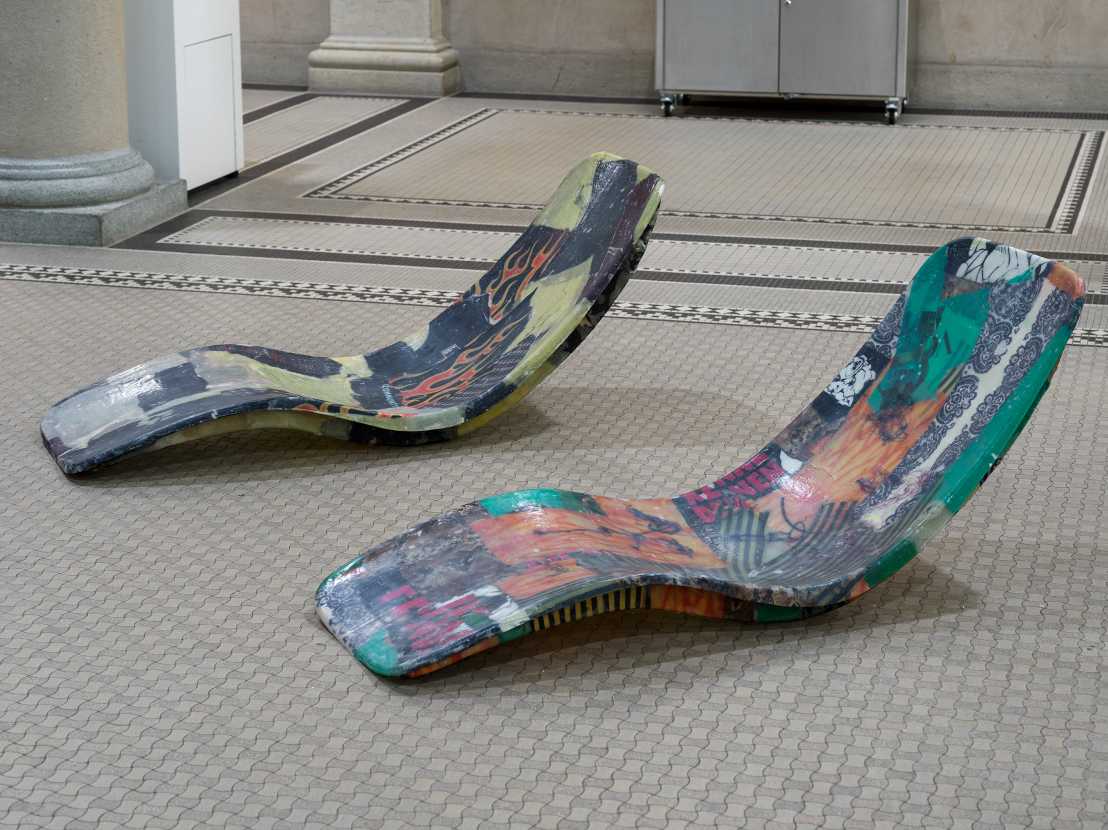
Martin Andereggen
Eurolaxxxers
2023
Disposed clothes, resin, fiberglass
6 parts, each: 160 x 63 x 60 cm
“Climate action now!” they shout on my iPhone. “Absolutely!” I hear myself say in a reassuring tone. I have been dozing in this old beach chair for an hour, and the sound of my voice makes me look around in embarrassment. No one seems to have noticed. Eurolax is the perfect name for this design, I think. Tilting your head back a little is enough effort to make the chair rotate into a vertical position, taking your mind away from the earth - towards the stars and the sky.
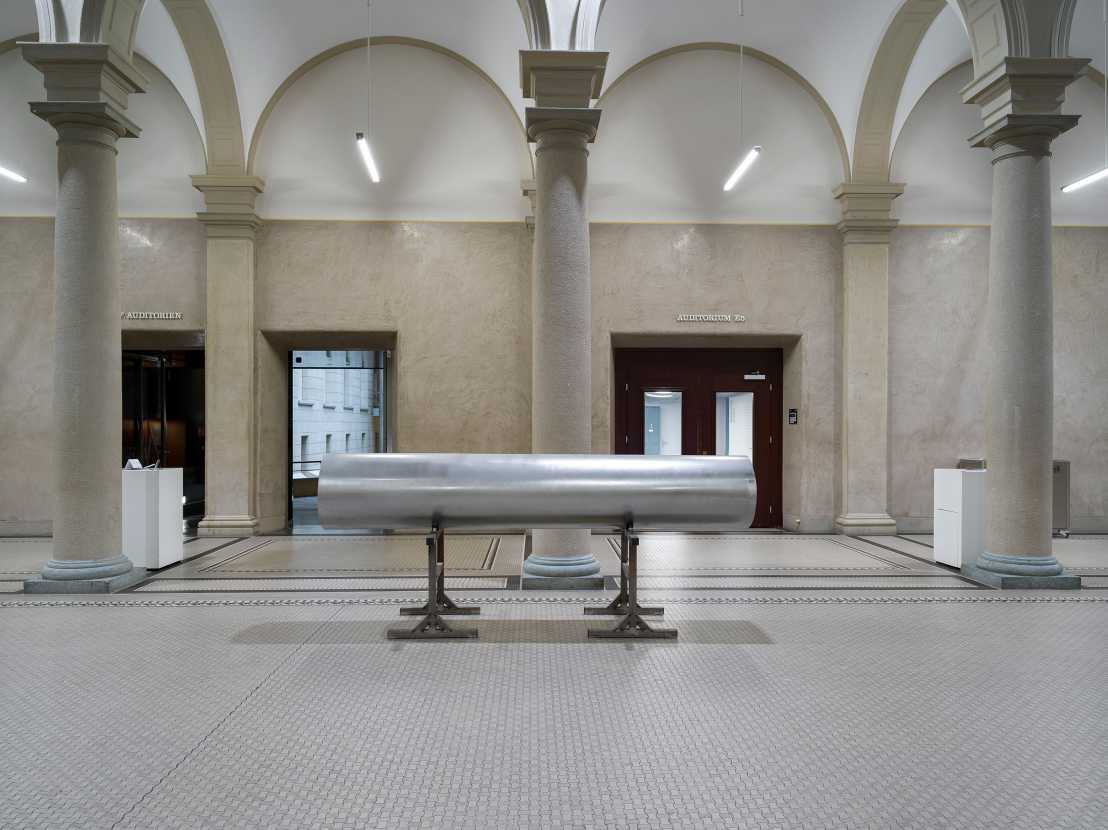
Aleyna Günay
Clarion Call
2023
Fiberglass, epoxy resin, paint, metal
300 x 60 x 130 cm
"Until yesterday, we were a family living peacefully in a small village.“
Not long ago, we decided to build a small house from scratch, located on the beach of the Barents Sea Beach. My little daughter, Eloise, helped collect biodegradable materials from the land we lived on. We wanted to have an environmentally friendly place to live together.
Eloise and her sister Jung were 6 years old when we adopted them from the orphanage of a former civil defense centre near Norway. After we adopted Jung, we realised that she had enhanced abilities. Extrasensory perception was one of them.
This has been a little bit of a summary of our family. Since we don't have anyone else living here, family means everything to us.
Yesterday Jung woke us up. It was too late for anything. We realised that we must have inhaled some toxic substance that someone had filled our house with while we were sleeping. Jung checked our body clock. It was as if we had been half asleep for years because of that substance. Someone was trying to incapacitate us.
Eloise and Jung left the house to figure out what's going on. We followed them. They were very brave to take over the situation. When Jung described what she saw, she said: ‘There were strangers doing construction on our land.’
And then Jung asked me, 'What are we going to do now, Mummy?' Eloise added, 'I want to know what's going on.’
I replied, 'They are looking for natural gas fields. We have to stay until they give up.’ Jung: ‘Perfect, exactly what I imagined.’ Barents Sea Beach, 2023
The Barents Sea Pipeline is a part of the Snøhvit development. The development consists of two fields that are already producing: Snøhvit and Albatross. The Askeladd field is the third discovery part of the Snøhvit development, which will be contributing to maintaining a full capacity utilisation at Melkøya LNG plant, outside the Norwegian city of Hammerfest. When developed, the Askeladd and Snøhvit total length of 195 km constitutes a world record of the longest subsea to shore tie-back distance. (1)
(1) FEED study on new pipeline in the Barents Sea Ramboll, July 7, 2018
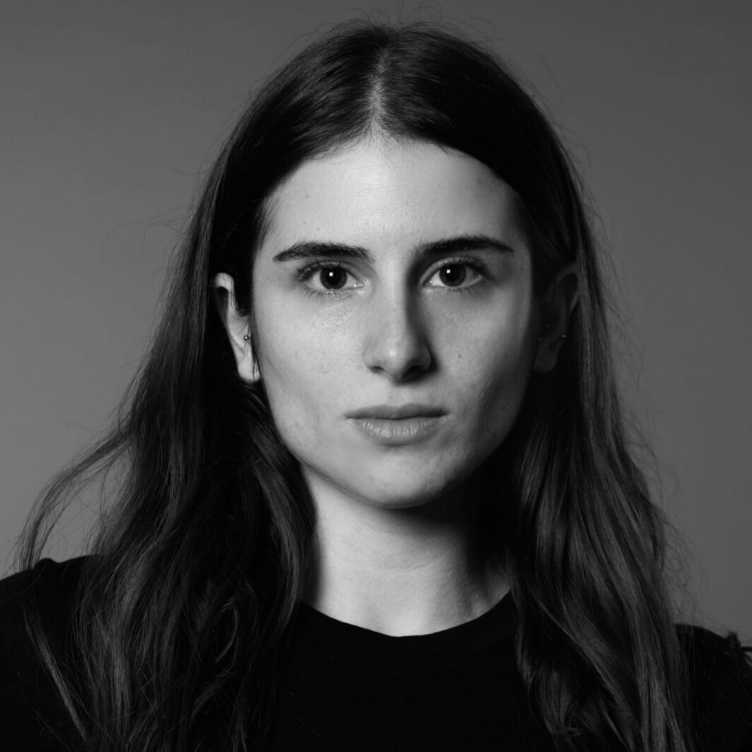
Aleyna Günay arbeitet mit unterschiedlichen Medien. Darunter Skulptur, Installation, Video und Sound. Ihre Fragestellungen befassen sich mit spekulativer Fiktion in nicht-traditionellen Formen. Sie reflektiert einen post-humanen Ansatz als Denkweise. Daneben komponiert sie Ton und Performances. Aleyna Günay lebt und arbeitet in Zürich.
external pagewww.aleynagunay.comcall_made
Instagram: external page@aleynagunaycall_made
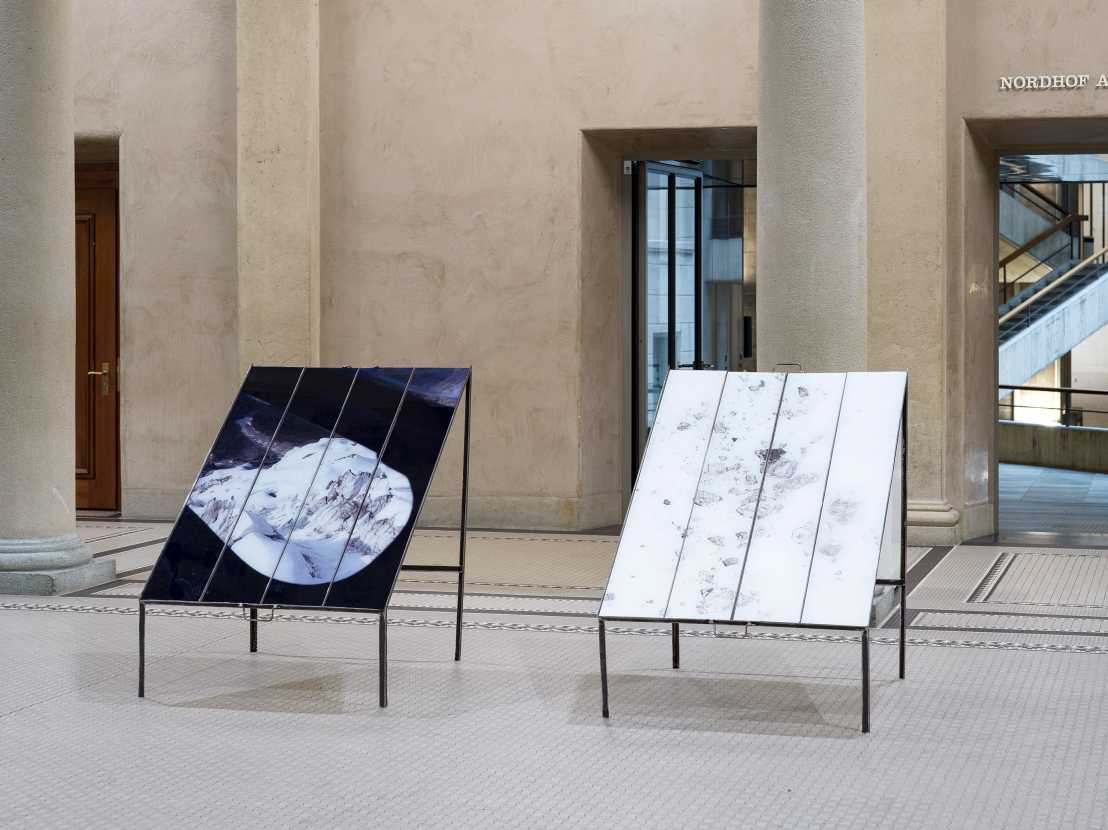
Arthur Heck
Tout Corps Prend Feu
2023
Steel, glass
2 parts, each: 150 x 100 x 125 cm
I made a series of photographs in collaboration with the teams of VAW's Glaciology group (Laboratory of Hydraulics, Hydrology and Glaciology, ETH Zurich). These images are fragments of my own experience of accompanying them on their fieldwork. They document an in-between time, a transition between a landscape that is disappearing and a new one that is taking shape. This photo series is a necessity for narrative rewriting. An emotional approach to issues of extinction. A desire for sentimental action.

Der in Straßburg geborene und in Zürich lebende Künstler Arthur Heck (geb. 2000) beschäftigt sich in seinem Werk mit den Verstrickungen von Intimität, sozialer Stellung und Sexualität. Ausgehend von einer Erziehung in der Arbeiterklasse reflektiert Hecks visuelle Produktion eine Notwendigkeit zur Flucht und einen Ausnahmezustand, in dem er über die Beziehung zwischen Körper und Veränderungen im Raum nachdenkt.
Instagram: external page@ahck._call_made
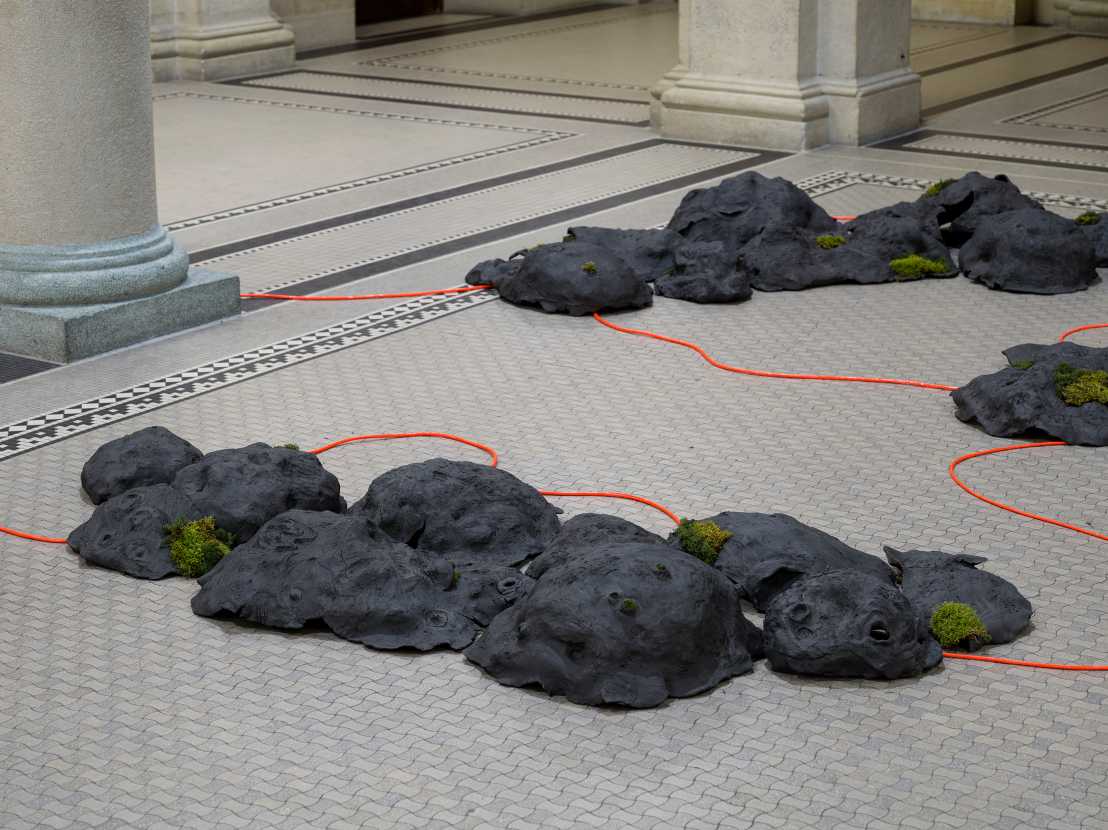
Francisca Patrocínio & Massimiliano Rossetto
fuzz fuzz
2023
Stoneware, moss, tape, audio system, 2-channel audio, looped
Dimensions variable
In fuzz fuzz, hand-moulded clay bodies emerge as echoes of natural spaces - an extension of a hypothetical inhabited landscape where encounters can take place. In exploring the relationship between organisms and the environment, the artists question ideas of sensibility and interdependence. The clay bodies are covered by moss belonging to the diverse group of bryophytes, small but vital plants made up of three distinct groups: mosses, liverworts and hornworts. Found in diverse ecosystems including forests, grasslands, wetlands, tundra and even cities, these plants play a critical role in the Earth's ecosystem, regulating water and nutrient cycles, providing habitats for other organisms and sequestering carbon from the atmosphere. With this work, the artist duo Francisca Patrocínio and Massimiliano Rossetto deepen the understanding of interconnections through sculpture and sound material, attempting to make a collective of organisms tangible. A place where bodies encounter each other in a landscape of wetness, fuzz and queer resilience.
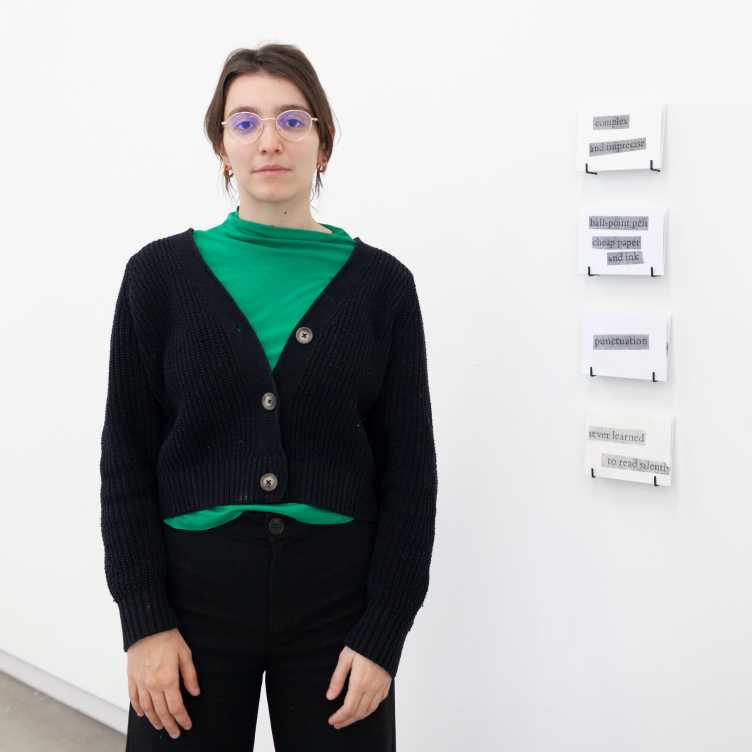
Francisca Patrocínio (1999, Porto) ist eine in Zürich lebende Künstlerin mit einem Hintergrund in Bildhauerei und Performance Art. Körper, Objekte und Raum sind zentrale Figuren in ihrer Forschung und experimentellen Praxis, in der sie über Verbindungen, Beziehungen und Gesturalität sowie die soziopolitischen und kulturellen Dimensionen dieser Konzepte in der heutigen Zeit nachdenkt.
external pagehttps://readymag.com/u4191845441/franciscacp/call_made
Instagram: external page@franciscacpatrociniocall_made

Massimiliano Rossetto (geb. 1993) ist ein schweizerisch-italienischer Künstler. Er hat einen Bachelor-Abschluss in Bildender Kunst und zeitgenössischer Fotografie von BLOO in Lyon. Derzeit absolviert er einen Master of Fine Arts an der Zürcher Hochschule der Künste. Seine Arbeit konzentriert sich auf die Interaktion des Menschen mit der Landschaft durch Fotografie und Skulptur, wobei er vielschichtige und ephemere Installationen verwendet. Er lebt in Zürich und Berlin.
external pagehttps://massimilianorossetto.com/call_made
Instagram: external page@massincall_made
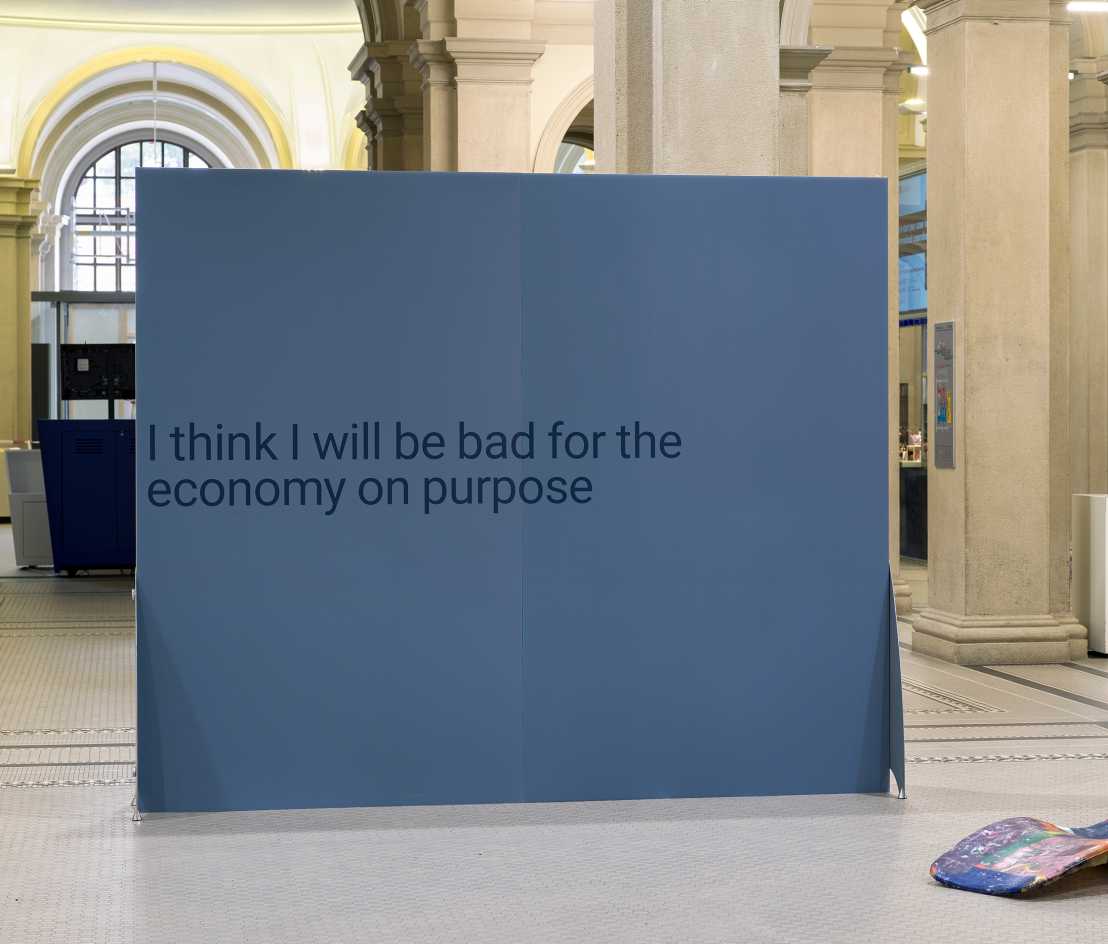
Schellinger Zaugg
I think I will be bad for the economy on purpose
2023
UV directprint on Forex, table talk
Dimensions variable
Why is it generally considered desirable to be good for the economy? Conversely why is it considered offensive to be bad for the economy?
The capitalist system has undoubtedly brought many benefits. Education, stability, social welfare or health for many people. But these benefits have been achieved through a reliance on steady growth, and therefore at the cost of exploitation of both people and the environment, to the extent that it now poses an existential threat to humanity.
So what possibilities does the individual have to take action? Bottom-up movements have always been important for social change. A rejection of status quo is a first step.
With I think I will be bad for the economy on purpose the artists offer ways to question existing systems and power structures. As part of the work, Schellinger Zaugg will run a public table talk, in which they discuss the topics with an audience.

Schellinger Zaugg
Stefan Schellinger (1995, Walchwil) und Samantha Zaugg (1994, Frauenfeld) studieren im Master Fine Arts an der Zürcher Hochschule der Künste. Zusammen sind sie 348 Zentimeter gross.
external pagehttps://samanthazaugg.chcall_made
external pagehttps://www.stefanschellinger.chcall_made
Instagram: external page@frauzauggcall_made and external page@555supercutcall_made
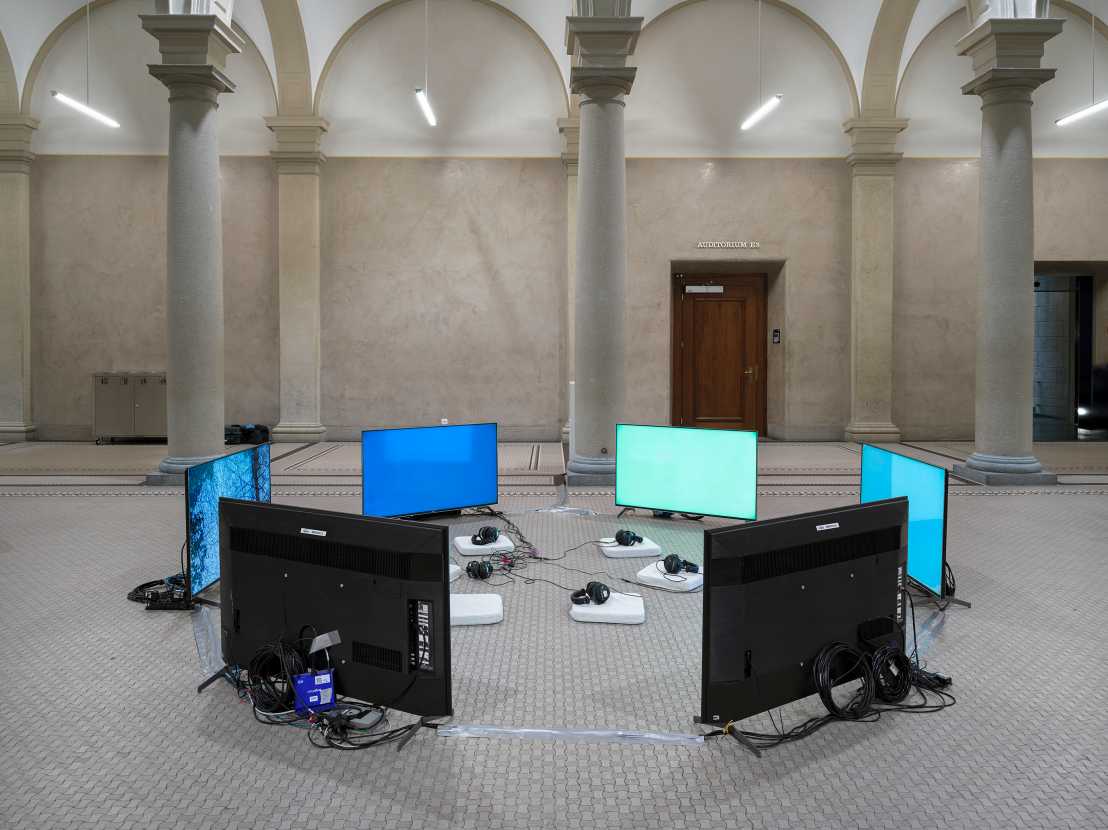
Yue Wu
The Mute Colours
2023
6-channel-video installation, audio recording (Dr. C. Schnadt Poberaj, Dr. P. Pothapakula, Prof. R. Jnglin Wills, Prof. N. Buchmann)
Duration: 35 min 42 sec
The Mute Colours is a six-channel video installation based on conversations with three climate scientists and one environmental scientist. Yue Wu’s interviews with experts on the perception of climate change are juxtaposed with images from the news, climate models and other visualisations of climate change. Colour plays an important role – monochrome colour fields covering the entire screen serve to structure the image-based narrative which is accompanied by audio of the scientists’ voices.
The use of the colours is inspired by the Warming Stripes created by scientist Ed Hawkins. The colours used here were originally extracted from minerals and plants. By researching ancient Chinese Buddhist sculptures and traditional Japanese colours, Yue Wu determined the origin of colours and their codes for digital production.
The installation reflects on the urgency of understanding climate change; the cause of climate change, the introduction of greenhouse gases, such as carbon dioxide and methane, and how climate change affects life; while the narration of the audio recording comes to the definition of three important ecosystem types in Switzerland; are they affected by climate change? How do they influence climate change?
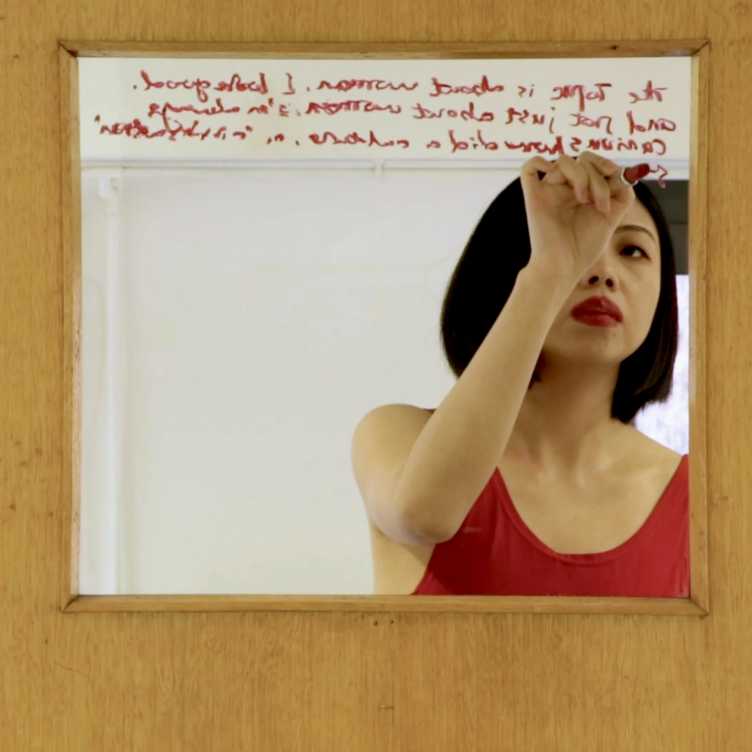
In Yue Wu's künstlerischen Praxis geht es um "Zeit" und "Weiblichkeit". Die Zeit oder Dauer als eine erweiterte, nicht-lineare Geste ist die von ihr gewählte Wahrnehmung des Geschehens. Um dies zu visualisieren, nutzt sie die Schleife von Ton und mehreren Videostücken in Kombination mit verschiedenen Technologien, um interaktive Installationen zu schaffen. Yue Wu identifiziert sich zutiefst mit der Weiblichkeit. Performance Art und Fotografie sind ihre Ausdrucksformen.
external pagehttps://www.yuewu.website/call_made
Instagram: external page@yuew_ucall_made
Impressum
- Die ETH-Klimarunde ist eine Veranstaltung des Center for Climate Systems Modeling (C2SM). Die diesjährige Klimarunde wird gemeinsam von C2SM, dem Energy Science Center (ESC) und der external pageZürcher Hochschule der Künste (ZHdK)call_made organisiert.
- Projektleitung: Tamara Bandikova (C2SM)
- Projektteam: Tamara Bandikova (C2SM), external pageNicola Genovesecall_made, (ZHdK), Reto Knutti (C2SM), Tanja Meier (C2SM), Christian Schaffner (ESC), Christina Poberaj Schnadt (C2SM), external pageCornelia Schwierzcall_made (MeteoSchweiz), external pageAnnina von Mentlencall_made (ESC), external pageJudith Weltercall_made (ZHdK)
- Grafik ETH-Klimarunde: Tanja Meier (C2SM)
- Fotograf ETH-Klimarunde: external pageTom Kawaracall_made
- Kuratorin: external pageJudith Weltercall_made (ZHdK)
- Grafik Kunstausstellung: external pageMartin Andereggencall_made (ZHdK)
- Fotografen Kunstausstellung: Cédric Mussano


